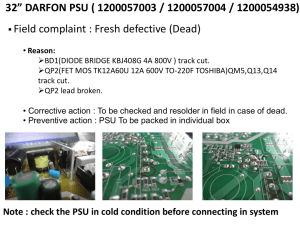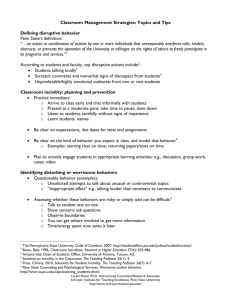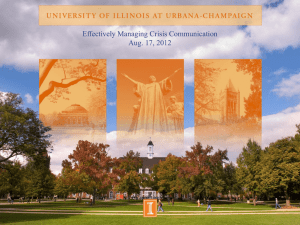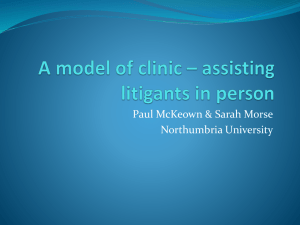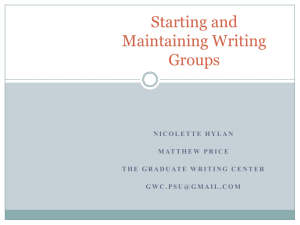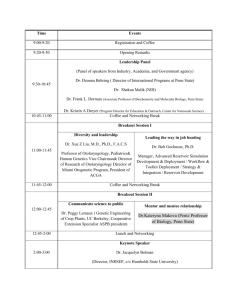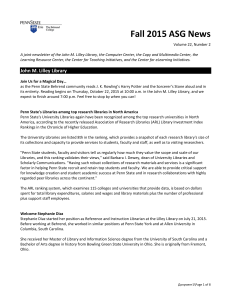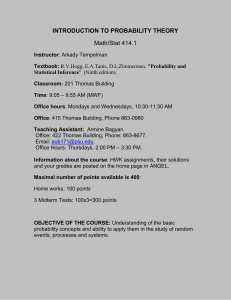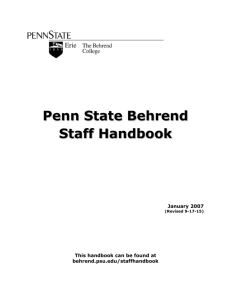2014-2015 - Penn State Behrend
advertisement
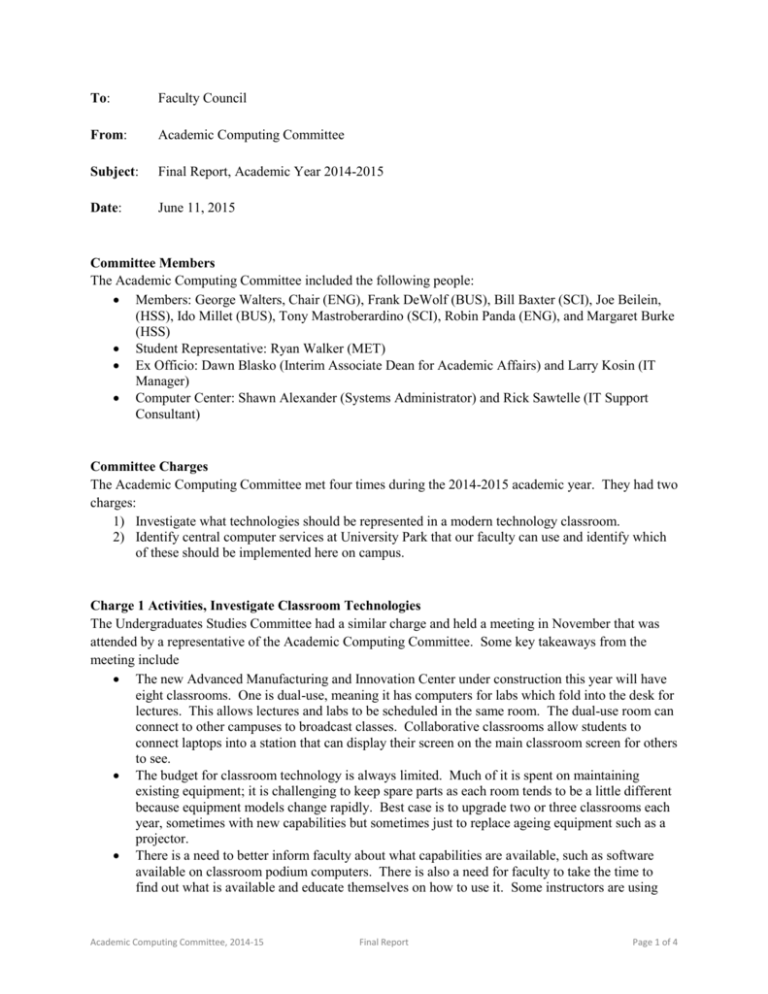
To: Faculty Council From: Academic Computing Committee Subject: Final Report, Academic Year 2014-2015 Date: June 11, 2015 Committee Members The Academic Computing Committee included the following people: Members: George Walters, Chair (ENG), Frank DeWolf (BUS), Bill Baxter (SCI), Joe Beilein, (HSS), Ido Millet (BUS), Tony Mastroberardino (SCI), Robin Panda (ENG), and Margaret Burke (HSS) Student Representative: Ryan Walker (MET) Ex Officio: Dawn Blasko (Interim Associate Dean for Academic Affairs) and Larry Kosin (IT Manager) Computer Center: Shawn Alexander (Systems Administrator) and Rick Sawtelle (IT Support Consultant) Committee Charges The Academic Computing Committee met four times during the 2014-2015 academic year. They had two charges: 1) Investigate what technologies should be represented in a modern technology classroom. 2) Identify central computer services at University Park that our faculty can use and identify which of these should be implemented here on campus. Charge 1 Activities, Investigate Classroom Technologies The Undergraduates Studies Committee had a similar charge and held a meeting in November that was attended by a representative of the Academic Computing Committee. Some key takeaways from the meeting include The new Advanced Manufacturing and Innovation Center under construction this year will have eight classrooms. One is dual-use, meaning it has computers for labs which fold into the desk for lectures. This allows lectures and labs to be scheduled in the same room. The dual-use room can connect to other campuses to broadcast classes. Collaborative classrooms allow students to connect laptops into a station that can display their screen on the main classroom screen for others to see. The budget for classroom technology is always limited. Much of it is spent on maintaining existing equipment; it is challenging to keep spare parts as each room tends to be a little different because equipment models change rapidly. Best case is to upgrade two or three classrooms each year, sometimes with new capabilities but sometimes just to replace ageing equipment such as a projector. There is a need to better inform faculty about what capabilities are available, such as software available on classroom podium computers. There is also a need for faculty to take the time to find out what is available and educate themselves on how to use it. Some instructors are using Academic Computing Committee, 2014-15 Final Report Page 1 of 4 existing infrastructure, such as podium computers and a projector, in ways that others might not think of. For example, one instructor has used Skype to connect the classroom to the author of a book for an interactive session. The Academic Computing Committee discussed the subject in its meetings. It was noted that the Computer Center is faculty driven, so communication between them and the faculty is critical. Different schools and programs have different needs, for example: It is important that Elementary Education students are exposed to technology commonly used in their profession such as smartboards. Science classes benefit from overhead cameras that allow the instructor to conduct an experiment and show it on the projector. Business labs could benefit from fold-down monitor stands or higher chairs so instructors can see students better while switching between brief lecture topics and hands-on computer work. Engineering labs could benefit from dual-monitor computers, allowing students to use programming or design software on one monitor and view documentation such as lab handouts, manuals, spec sheets, etc on the other. Charge 2 Activities, Identify Computer Services Available from University Park The Academic Computing Committee discussed this subject in its meetings. The thought was that there are probably computing resources available at University Park that our faculty could use, at no or low cost to us, but we do not take advantage of simply because we don’t know about them. For example, the CSE department lists resources such as high performance computing (HPC) on their web site, The link to www.cse.psu.edu website. Another example is the Penn State Institute for CyberScience, ics.psu.edu, which was created to enable research in the Life Sciences, Material Science, Energy and the Environment, and Social Sciences, and can be a high performance computing resource for other fields. Yet another example is lynda.psu.edu, which hosts online video training and tutorials of interest to staff, faculty and students. Examples include writing proposals, flipping the classroom, time management, and others. The committee discussed compiling a list of resources and posting them somewhere. Several points of interest came out of the discussions: IT noted that they are already looking at this. Where would such a list be posted? Would it just be another web page that most people don’t know about? Who would maintain it? Faculty already have information overload. One example is the emails broadcast to the faculty, the result is that many faculty ignore them or block them. This should be a consolidation of information effort rather than an effort to create more information (and duplicate information). ITS already has a significant list at its.psu.edu, and it would be inefficient to create a similar resource. Other Activities The committee assisted IT in their initiative to downgrade faculty rights on their office computers. Previously, faculty had Administrator privileges on their computers, now they have user privileges by default. An ITS white paper notes that over 90% of critical vulnerabilities can be mitigated by removing Administrator privileges. The importance of this is underscored by the recent report that the Penn State Academic Computing Committee, 2014-15 Final Report Page 2 of 4 College of Engineering computers have been accessed by hackers for over two years. Members of the committee served as the initial test group. They provided feedback to IT and helped inform their departments about the initiative. Faculty who need Administrative privileges can request them through a designated point of contact in their School. The initiative was completed smoothly and is an example of the value of good communication between IT and the faculty through the computing committee. The committee discussed a potential third charge to explore making Behrend a more information-rich environment by allowing students, faculty and visitors with smart phones to use near-field communications or QR codes to get location-specific information, such as checking lab use/availability, identifying office hours, getting information about research done in a lab, etc. The committee did not take up this charge, one reason being that unless it was widely implemented it would be ineffective or possibly have negative results. For example, if a visitor looked for information on labs but found that most didn’t have any, that might give them a negative impression. Findings and Recommendations Related to Charge 1 o The school already has good classroom technology in place. Although faculty may sometimes take for granted that there is a computer podium and projector in each classroom and want more, it is a powerful platform. Some faculty are leveraging what we have, such as using Skype, in ways that others have not thought of. There is a need to share these ideas to get the most out of what we already have. Installing free or low cost software to podium computers can leverage what we have in a cost effective way. o There are additional technologies that would be valuable, such as smart boards, but there is limited budget. Spending on technology is faculty driven, so better communication between IT and faculty about the benefits of these technologies will help set priorities for spending in the future. Related to Charge 2 o There are many computing resources available that many people probably do not know about. Below are two good places to start. Consider adding links to these on the “Faculty & Staff” and “Current Students” pages that are accessible from the Penn State Behrend home page on the Web: The ITS Website, its.psu.edu The online training library, lynda.psu.edu Strengthen and improve communication between IT and faculty o The benefits of improved communication was a recurring theme in almost every discussion. It would resolve or reduce the impact of many issues in the first place. o Look at creating a standing committee in each School (if they don’t already have one) for computing. One of the recommendations of the Faculty Affairs Committee is that each School align their committees with the faculty council committees to increase dialog and collaboration. One or both representatives on the Academic Computing Committee from each School should also serve on the School committee to facilitate communication. With this in place, IT could ask for faculty feedback from the Academic Computing Committee members, which would be passed on to school committee members, and Academic Computing Committee, 2014-15 Final Report Page 3 of 4 could get a timely response from a significant number of faculty that would represent diverse interests. Possible Charges for Next Year The following are suggested charges for the 2015-16 committee to consider: Create a standing committee in each School for computing (that doesn’t already have one) o The goal would be to have the committees in place for the following year. o If a School does not have a significant need for such a committee, the committee might only have the responsibility of representing their departments when IT requests feedback or implements future initiatives. o School committees would have the standing charge to facilitate communication between IT and the faculty Create a standing charge to facilitate communication between IT and the faculty o This has been done to some degree by including representatives from IT in meetings. Making it a standing charge would reflect its importance and make it a higher priority. o This would be enhanced by creating a computing committee in each school. Investigate ways to reduce information overload and improve campus-wide communication o Look at how to improve email broadcasts to faculty. One way might be to add tags to the subject line, such as “Athletics”, “Academics”, “Research”, “Training”, etc. so that faculty can apply filters. Investigate ways to leverage smart phones, tablets, etc. o Investigate available apps that may be useful, such as for replacing iClickers o Identify needs that can be met by a custom app that could be developed by students. For example, students created a system that tracks the location of the campus shuttle bus, which can be viewed on a smart phone. o Consider how to accommodate students that to not have a compatible device Academic Computing Committee, 2014-15 Final Report Page 4 of 4


